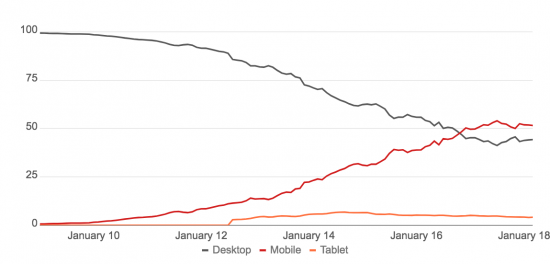Mobile First Index - impact on SEO & practical tips
Google's Mobile First Index has shocked many website operators. We deliver insights
It is now almost a year and a half since Google first spoke of a Mobile First Index, but now on 26 March 2018 the time had come: In Google News the rollout was finally announced.
But what does this mean for search engine optimization? Does anything have to be adjusted at all? Or perhaps everything?! Is the current mobile SEO sufficient? Or could this become a MOBILE CALYPSIS?
One thing in advance: No, it is not that bad. But there are a few points that webmasters should be aware of in order to advance their SEO efforts.
Mobile First? Not a coincidence!
It's no secret that until now the desktop version of a page has been Google's primary point of reference for measuring site performance. So it was always the case before that most search queries were made via desktop.
However, since the smartphone boom and developments such as ROPO (Research Online, Purchase Offline), there has been an increasing upward trend in Google search queries via mobile devices. These already accounted for more than 50% of all search queries worldwide in October 2016.

With such a development, it makes sense to provide this majority of users with optimal search results and lo and behold: the Mobile First Index celebrates its debut.
Are you already on the Mobile First Index?
In Desktop First times, 80% of Googlebot activity was performed by a desktop crawler and 20% by a mobile crawler. When Google switches to Mobile First indexing, these values are swapped. The webmaster should be able to recognize this change based on the server logs.
If you have registered your website in the Google Search Console, you will also be notified there in case of a change.
Being ready is everything
If you have already performed mobile SEO via a separate website, dynamic serving or a responsive design, you can generally say of yourself: You are ready!
As the Google Mobile First Index might already tell you by its name, the mobile version of your website will be checked first. This does not mean that the desktop version is no longer relevant. This is still checked by the Googlebot. However, high quality content is still of paramount importance and is not necessarily pushed aside by better mobile design or site performance.

However, it would be prudent to make his website mobile friendly for a better user experience. Google recommends using a Responsive Design.
Responsive Webdesign - One size fits all
With Responsive Design the website automatically adapts to the size of the respective display. The advantage of this is that only one web page needs to be created and all content is therefore available via one URL.
This offers several advantages:
- Only one website has to be created and there is only one URL
- This combined authority makes SEO easier
- Crosslinking between mobile and desktop version is not necessary
Google recommends this concept because only one page with one content needs to be crawled and this saves, apart from creating your mobile website, it is always useful to follow a few proven methods for mobile SEO.
Mobile First SEO – Best Practices
- Speedup of your website: The website speed is especially important for mobile devices. The bounce rate is particularly high on mobile devices, so the site speed must be kept as fast as possible.
- Avoidance of interstitial pop-ups: Penetrating pop-ups already on the homepage are an absolute user experience killer and often ensure a direct jump.
- Link Equity & Cross-Linking with multilingual websites: With a separate website for mobile devices it is important that there are no accidental links from mobile to desktop and vice versa. It can quickly happen that a smartphone user finds himself on a desktop page that is unmanageable for him.
- Same content for mobile & desktop (duplicate content): The content does not have to be identical between the mobile and the desktop version, but equivalent. After all, the website is supposed to present a content.
- Structured data for Position Zero: Due to the increasing area of Google Ads in search results, it is especially important to stand out. Structured data is of particular use and has a high potential for voice search.
Conclusion
Google's Mobile First Index 2018 is now not the mobile galaxy you might think at first thought. Desktop pages still have their relevance and remain indexed, albeit with a much smaller crawling budget. Websites that are already mobile optimized will not see any major changes in the ranking for the time being.
However, if you don't have a mobile website yet, it's high time you did! The upward trend for mobile devices is still ongoing and more and more users will submit their search queries via their mobile phones. Therefore, mobile first focused SEO is without a doubt an increasingly important factor for the future.
More information can be found in our webinar: "Everything mobile or what? How Google's Mobile First Index works".










